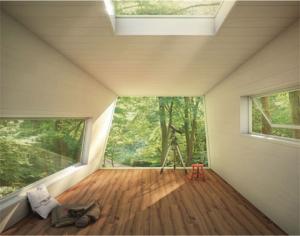Home is Where the Carbon Isn’t
Submitted by Sabrina Lavi on | Updated Tue, 11/10/2016 - 17:56

Since Al Gores’ An Inconvenient Truth made its debut in 2006, the move towards a sustainable way of living has become a widespread phenomenon, penetrating the ethos of individuals and communities. Even before the turn of the twenty-first century, many non-for-profit organizations, environmental coalitions and the like, have been spreading the word about climate change and the associated effects humans are causing to planet earth, especially as it relates to carbon remittance.
We’ve all heard the benefits of reducing our individual carbon footprint. Whether it’s taking shorter showers, buying locally grown and produced goods or electing to take public transit, the signs that a much needed shift towards a sustainable way of living are imminent. This is because our lifestyles dictate a lot of how much we, as consumers, contribute to climate change. In response to this growing concern, many people across the country have opted to make the choice towards a more sustainable way of living. For some individuals, it has prompted them to make a truly grass roots change from the ground up and invest in an eco-friendly home.
Imagine the place where you call home produces very low electricity bills, and helps reduce your individual contribution to climate change? Envision little to no mortgage payments and the choice to design your own home. Sounds too good to be true? Think again! A “zero carbon” or “eco-home” is essentially a dwelling designed to reduce the remittance of any carbon dioxide or other greenhouse gas emissions on a net annual basis by replacing the energy with renewable energy, according to Carbon Busters. Eco-homes achieve this by supplying more energy to the energy grid than they take.
Outside of having an a-typical design and look, carbon free homes are distinct from regular homes, as eco-friendly homes are able designed to fix the inefficiencies associated with heating spaces, ventilation, water and lighting. This is made possible by installing rooftop solar panels, rooftop planting, and superinsulation.
Not only does an eco-home allow you the freedom to choose the materials you construct the home with, the cost of designing, constructing and building, an eco-home costs significantly less than the cost of an average home. For example, Earthship Biotecture, a company that designs and builds homes was able to construct a home in southwestern Ontario containing approximately 45-percent reused materials. These materials included plastic and glass bottles, cans, reclaimed wood, natural plaster and stone, and reclaimed metal from washing machines and refrigerators.
If you decide to build a home from scratch, you may need to consult with your local municipality or city zoning bylaws to ensure you have the authority to build and that your designs meet the criteria for housing in your area. However, the prospect of building your own home that saves you money and the planet is a worthwhile investment to consider.
For example, consider this solar powered home in Edmonton, Alberta. The 1,540 square foot bungalow runs mostly on solar generated power, occasionally drawing from the electrical grid. What makes this home capable of harnessing solar power for so long? Concrete floors on the main level absorb the sun’s rays, helping to heat the home. In particular, the home’s foundation is insulated with twelve-inch walls made of engineered wood and expanded polystyrene to provide insulation, according to Effect Home Builders.
If you’re not quite ready to commit to a full fledge zero carbon home, but want to do your part and save some cash, here are some adjustments you can consider making to your current home that will ease your carbon footprint and save you money:
Windows: application of Low-E, a special coating when applied to windowpanes reflects heat back into the house, reducing the loss of heating, as unsealed airways can contribute up to 1,300 pounds of greenhouse gas emissions annually.
Wood Heating Fireplace: masonry fireplaces produce low emissions and serve as a reliable heat source. Despite the fact that the extraction, removal and harvesting of trees can be damaging, planting trees in your neighborhood and in and around your property is a great way to off-set this.
Walls: using drywall that is made from 95% recycled materials is great way to incorporate recycled materials into the internal structure of your home.
Waste Water Heat Recovery: heat is recovered from waste water used in showers, dishwashers and washing machines and then the heat is used to pre-heat additional water, saving on heating costs.
Kitchen Floor Tiles: application of Darotop concrete surface, whereby furnace heat is moved throughout the flooring of the home and will reduce the need to utilize the furnace.
Energy Star Appliances: purchasing these types of appliances can save you a lot of money and reduce your energy consumption. For instance, Energy Star dishwashers use 41% less energy and 30% less water than non-energy star appliances.
Flooring: choose Bamboo based flooring, as it is a more sustainable and durable choice.
On a larger scale, by replacing all showerheads with low flow showerheads, seal all airways, windows, door and vents. In addition, by installing low flush toilets and combining your furnace and hot water tank by installing a combined system using a high efficient condensing water tank will you save 2.68 tones of Co2, which is equal to reducing annual car emissions by 0.8 passengers, diverting 1,003 kg of garbage from a landfill into recycling and reducing the overall annual electricity use in five ones by 30%.
However, if you were to install a drain recovery system to at least one shower or toilet, boost your ceiling insultation, replace your windows with energy star windows, you could save 1.68 tonnes of Co2, divert 629 kg of garbage, reducing your household emissions by 11%
While making these changes to your current home may be costly upfront, nevertheless, you can rest assured that these investments will have a lasting impact. The real challenge lies not only in augmenting and upgrading our living spaces, but upgrading our behaviors too. Choosing to live sustainability is as much a physical change, as it is a cognitive change to our habits and overall lifestyle choices. Choosing to make small physical changes to your home’s flooring and windows as well as how we use appliances within the home, goes a long way to preserving our planet. After all, the place where you call home should be somewhere you recuperate and preferably without carbon.
For more information about how you reduce your carbon footprint and save money, check out this carbon calculator: https://ecoliving.scotiabank.com/calculate-savings
Additional Resources:
http://inhabitat.com/6-eco-friendly-diy-homes-built-for-20k-or-less/
http://www.sustainablehouse.ca/virtual-tour/
http://www.nature.org/greenliving/carboncalculator/
http://www.carbonbusters.org/index.php
http://www.greenlivinghomes.ca/edmonton-home-plans/http://www.edmontonjournal.com/homes/shines+energy+efficient+home+edmonton/6643501/story.html
You will save the Earth by sharing and/or tweeting (corny right?)





